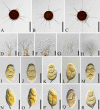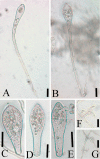Phylogeny and taxonomy of Phyllactinia species (powdery mildew: Erysiphaceae) occurring on the ash trees (Fraxinus spp.)
- PMID: 37092168
- PMCID: PMC9721523
- DOI: 10.47371/mycosci.2021.04.001
Phylogeny and taxonomy of Phyllactinia species (powdery mildew: Erysiphaceae) occurring on the ash trees (Fraxinus spp.)
Abstract
The genus Fraxinus (Oleaceae), known as ash trees, currently comprises 43 recognized species that are distributed in temperate and subtropical regions of the Northern Hemisphere. Two Phyllactinia species, P. fraxini and P. fraxinicola, have been known on Fraxinus spp. so far. In this study, powdery mildews belonging to Phyllactinia were collected on Fraxinus spp. from different areas of the world to make molecular and morphological analyses. These specimens are divided into four distinct molecular phylogenetic groups, which are distinguishable by their morphology and/or host preference. Two new species, viz. P. japonica occurring on F. sieboldina and F. lanuginosa f. serrata, and P. fraxini-longicuspidis on F. longicuspis, are proposed in this study. An epitype is designated for P. fraxini. This study indicates very high host specificity among the four Phyllactinia species on Fraxinus, suggesting that genetic isolation by host specificity played a more important role than geographic segregation in the speciation events of these Phyllactinia species. Evolutionary timing calculated by molecular clock analysis suggests that these powdery mildews diverged in accordance with host phylogeny after divergence of host plants.
Keywords: Phyllactinia fraxinilongicuspidis; Phyllactinia japonica; biogeography; epitype; new species.
2021, by The Mycological Society of Japan.
Figures










Similar articles
-
Phylogeny and taxonomy of Erysiphe species (powdery mildew: Erysiphaceae) occurring on the ash trees (Fraxinus spp.).Mycoscience. 2021 Mar 20;62(2):115-123. doi: 10.47371/mycosci.2020.11.009. eCollection 2021. Mycoscience. 2021. PMID: 37089256 Free PMC article.
-
Early evolution of endoparasitic group in powdery mildews: molecular phylogeny suggests missing link between Phyllactinia and Leveillula.Mycologia. 2016 Sep;108(5):837-850. doi: 10.3852/16-010. Epub 2016 Jun 13. Mycologia. 2016. PMID: 27302046
-
Comprehensive molecular phylogenetic analysis and evolution of the genus Phyllactinia (Ascomycota: Erysiphales) and its allied genera.Mycol Res. 2008 Mar;112(Pt 3):299-315. doi: 10.1016/j.mycres.2007.11.014. Epub 2007 Dec 14. Mycol Res. 2008. PMID: 18308528
-
Taxonomy and phylogeny of the Erysiphe lonicerae complex (Helotiales, Erysiphaceae) on Lonicera spp.Fungal Syst Evol. 2021 Jun;7:49-65. doi: 10.3114/fuse.2021.07.03. Epub 2020 Nov 26. Fungal Syst Evol. 2021. PMID: 34124617 Free PMC article.
-
Sequencing Herbarium Specimens of a Common Detrimental Plant Disease (Powdery Mildew).Phytopathology. 2020 Jul;110(7):1248-1254. doi: 10.1094/PHYTO-04-20-0139-PER. Epub 2020 Jun 3. Phytopathology. 2020. PMID: 32407253 Review.
Cited by
-
Phylogeny and taxonomy of Podosphaera filipendulae (Erysiphaceae) revisited.Mycoscience. 2021 Nov 20;62(6):390-394. doi: 10.47371/mycosci.2021.07.001. eCollection 2021. Mycoscience. 2021. PMID: 37090177 Free PMC article.
-
Novel powdery mildew of cotton (Gossypium hirsutum) caused by Phyllactinia gossypina sp. nov. in Brazil.Braz J Microbiol. 2024 Sep;55(3):2845-2854. doi: 10.1007/s42770-024-01423-w. Epub 2024 Jul 1. Braz J Microbiol. 2024. PMID: 38951477 Free PMC article.
References
-
- Blumer, S. (1967). Echte Mehltaupilze (Erysiphaceae). Ein Bestimmungsbuch für die in Europa vorkommenden Arten. Jena: Gustav Fischer.
-
- Braun, U.(1985). Taxonomic notes on some powdery mildews (V). Mycotaxon, 22, 87–96.
-
- Braun, U.(1987). A monograph of the Erysiphales (powdery mildews). Nova Hedwigia, 89, 1-700.
-
- Braun, U., & Cook, R. T. A. (2012) Taxonomic Manual of the Erysiphales (powdery mildews). CBS Biodiversity Series No. 11.Utrecht: CBS-KNAW Fungal Biodiversity Centre.
-
- Edgar, R. C. (2004) MUSCLE: Multiple sequence alignment with high accuracy and high throughput. Nucleic Acids Research, 32, 1792-1797. https://doi.org/10.1093/nar/gkh340 - PMC - PubMed
LinkOut - more resources
Full Text Sources
Research Materials
Miscellaneous
